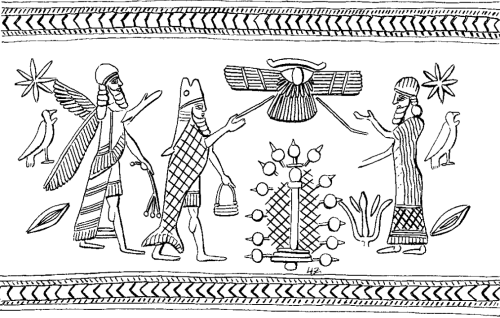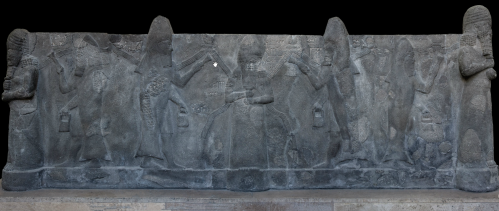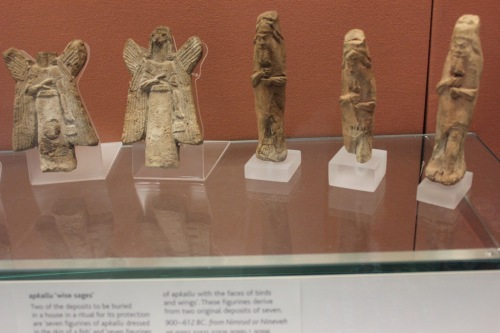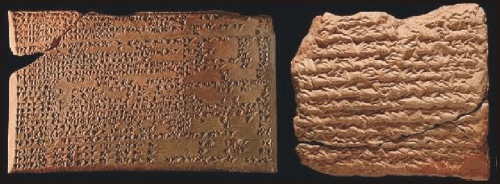Dalley: Apkallu-3, IDD 2011
Iconography of Deities and Demons (IDD).
Apkallu (continued).
Type 1 Human-figured Apkallu, Phenotypes.
“The human-figured sage (1* – 39*), sometimes called winged genie, should probably be identified with Akkadian ūmu–apkallu. If so, it is the only sage-figure that has a distinguishing term. Alternatively, ūmu-apkallu may be an extension of apkallu in which ūmu refers to Oannes, the first sage, as an ummiānum.
The human-figured Apkallu is always shown in profile, and is normally bearded. He often wears a headband decorated with rosettes, or a horned crown with one, two, or three pairs of horns; he wears light sandals or is barefoot.
Occasionally he is kneeling (7 , 19, 24–25, 33*–34). He usually has two wings on palace sculptures of Assurnasirpal II (883-859 BCE) (6*), two (37) or four (23) wings in the palace of Sargon II (721-705 BCE), and four wings in the time of Sennacherib (704-681 BCE) (22).

This ummiânū kneels before the sacred tree, apparently depicted in the act of tending to it.
This bas relief is perhaps unique in its fine detail which survived a long passage of time.
Note the care focused on the fingernails and toenails.
The rosette design is mirrored on the bracelets, while this ummiânū wears a dual-horned tiara of divinity.
The tassels from the apparel are finely detailed, and another tassel appears behind the ummiânū’s neck, beneath his braided hair.
The earrings are of an unknown design.
However, exceptions such as on 2 can be found, and there is probably flexibility in peripheral iconography or due to deliberate archaism.
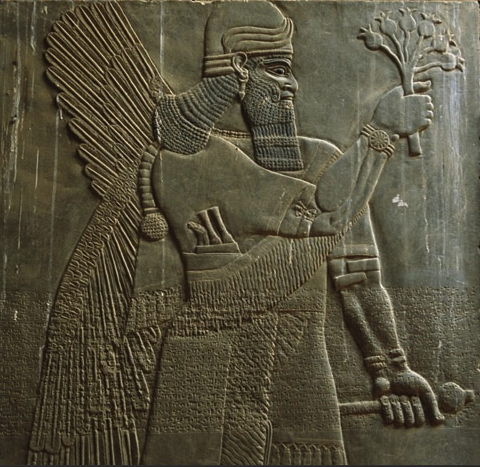
This umu-apkallu wears a three-horned headdress indicative of divinity, raises poppy bulbs in his right hand, and holds a mace in his left. He has four wings.
Daggers and ornate whetstone are tucked into his waistband, he wears armlets, and the fine detail preserved in this bas relief is highlighted by the right-armed sleeve of his upper garment.
Ada Cohen & Steven E. Kangas, eds., Assyrian Reliefs from the Palace of Ashurnasirpal II: A Cultural Biography, UPNE, 2010, p. 6.
https://books.google.co.th/books?id=uRKU0YXBWtgC&pg=PA252&lpg=PA252&dq=D.+Kolbe+Die+Reliefprogramme+full+text&source=bl&ots=c4EZtivZGc&sig=2MJlM039UK3pZ0ituhzBzLBys4M&hl=en&sa=X&ved=0CCoQ6AEwBWoVChMIipCB8K–xwIVDlqOCh2O_wYD#v=onepage&q&f=false
On Khorsabad sculptures of the late 8th century (23), the four-winged man, holding a bucket and cone and wearing a crown with three pairs of horns, is probably a form of the same figure.
A beardless, perhaps female, two-winged form with bucket and cone is found on 8th century Carchemish sculpture fragments (30). It may be comparable to the two- or four-winged, perhaps female, figure in the palace of Assurnasirpal II, who holds a jeweled ring in the left hand, and wears a necklace and a crown with two pairs of horns (1* – 2).

Stephanie Dalley’s “beardless” type 1 apkallu. Aside from being beardless, these feminized apkallu wear atypical necklaces and hold what appear to be looped stones or prayer beads in their left hands.
They appear to wear long skirts, and details of their upper garments are lacking. They have four wings.
Typical rosette bracelets adorn their wrists, and they wear armlets at the elbow as is common.
Both umu-apkallu wear a dual-horned tiara indicative of divinity, as they salute a sacred tree in its prototypical configuration.
Although the figure is almost certainly female, it has two daggers and a whetstone tucked into the waist on 1* – 2, implying perhaps ambiguity of gender (ALBENDA 1996). Beardless examples are quite common in 7th century Urartian art (24, 27–29).
Associations.
The human-figured Apkallu is rarely associated with a deity (27).
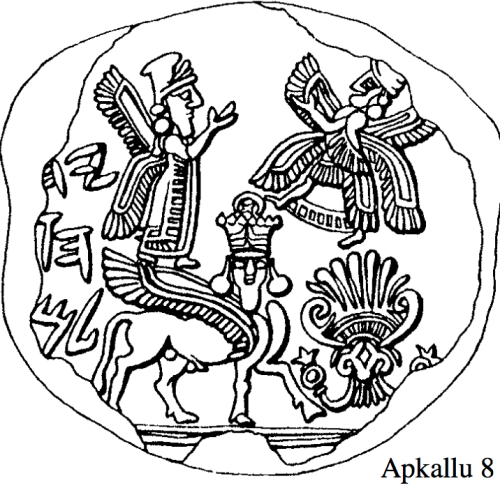
Apkallu type 1, Illustration 8, Stephanie Dalley, IDD.
Dalley notes that this “Hebrew seal” may not be genuine, as it features a winged, man-faced bull “Aladlammu” serving as a “pedestal animal for a divine figure.”
What intrigues me is the crown worn by the man-faced bull, which resembles the crown portrayed on previous depictions alleged to be the god Anu. I do not propose that this man-faced bull is Anu, but his dual-horned headdress is surmounted by a disc-shaped device which is more ornate than the headdress on any other figure on this seal. The crown in this context is problematic, and it raises questions.
Dalley compares illustration 8 to illustration 9, below, as “another West Semitic or (or rather South Semitic) seal with this type of apkallu standing alone.”
In a few cases the human-figured Apkallu is associated with hybrid animals (24), as on the Hebrew seal 8* (if genuine), where a winged, man-faced bull Aladlammu (Human-headed winged bull) serves as a pedestal animal for a divine figure; and on 11, where an unbearded, human-faced winged lion sphinx supports the mirror-image pair of Apkallu.
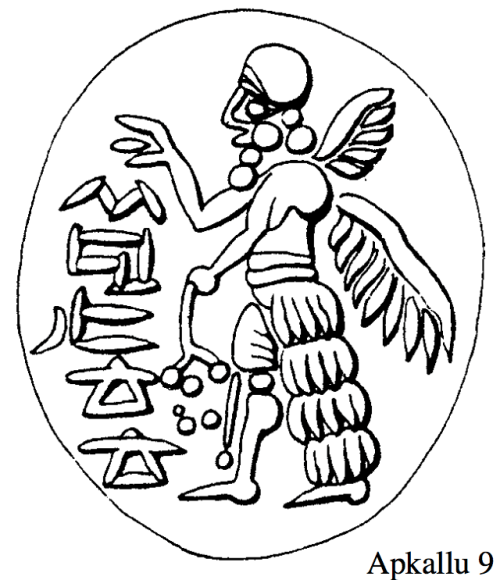
Apkallu type 1, Illustration 9, Stephanie Dalley, IDD.
Dalley compares this seal portrayed as illustration 9 with illustration 8 above, as “another West Semitic (or rather South Semitic) seal with this type of apkallu standing alone.”
For me, the indistinct head gear stands out, as does the portrayal of the poppy bulbs in the left hand.
If genuine, 9* is another West Semitic (or rather South Semitic) seal with this type of Apkallu standing alone.
Mirror-image pairs stand on each side of a stylized sacred tree (1*, 7, 13, 24, 29, 39* ), the tree sometimes surmounted by a winged disc (11–12*).
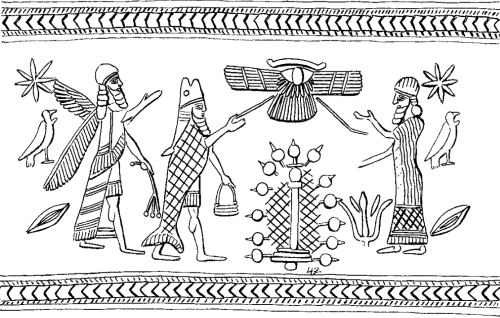
Apkallu type 1 and type 2, Illustration 12, Stephanie Dalley, IDD.
Dalley emphasizes the “winged disc” in this exemplar.
This may be a case where we are programmed to expect a winged disc, but in this case, the “winged disc” appears to portray a stylized eye.
To me, the winged conveyance resembles an Eye of Horus, complete with an eyebrow. I do not propose that this illustration is an Eye of Horus. I merely observe that this portrayal of the winged conveyance in this case resembles one.
This scene is frequently attested on palace sculptures from the Northwest Palace of Assurnasirpal II (883-859 BCE) at Nimrud (6*; PALEY/SOBOLEWSKI 1987; 1991 passim). The scene is found in a location of high prestige, on a panel set behind the throne dais in the main throne room, where the king stands in mirror-image at the tree, and the winged disc is also shown.
Occasionally the winged disc is supported by a kneeling atlantid figure (14* ). Other variations include streams of water coming from the winged disc (14 *).
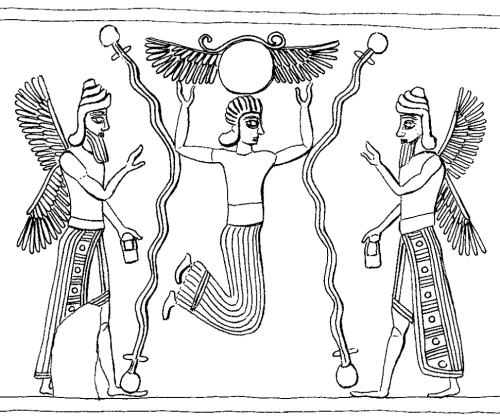
Apkallu type 1, illustration 14, Stephanie Dalley, IDD.
As Dalley notes, these type 1 apkallu have banduddu buckets in their left hands and appear to be gesturing with empty right hands. They are remarkable for crowns or tiaras with three horns, an indicator of divinity, or in the case of the umu-apkallu, of semi-divinity.
The central figure appears to be suspended beneath a winged disk. Unlike the apkallu, the central figure is beardless and without wings.
The wiggly lines probably portray water, flowing between what appear to be jugs.
Mirror-image figures may also stand on either side of a doorway without a central motif such as a sacred tree. On the rare occasions when this type does not belong to a mirror-image arrangement, he may stand, for example, behind a man with a fly-whisk and bowl, facing the enthroned king (26).
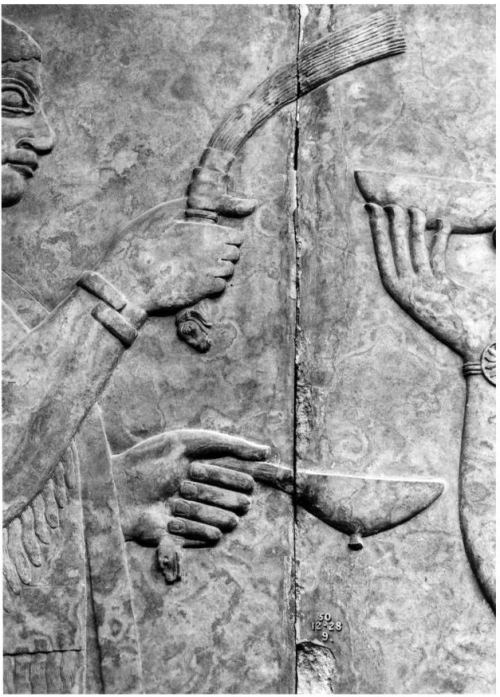
Detail on the whisk and the cup in the hands of a priest. This bas relief is singular in its fine detail and superb preservation. The individual strands of the fly whisk are readily apparent, as is the detail of the lion headed handle beneath the hand of a beardless priest. The fingernails are clearly visible.
A snake-headed handle from what appears to be a ladle is apparent in the lower hand.
From Panels 2-3, Room G, Northwest Palace of Ashurnasirpal II at Nimrud.
London, British Museum ANE 124564-124565.
Photo: Mehmet-Ali Atac, The Mythology of Kingship in Neo-Assyrian Art, 2010, p. 99.
The type occurs as a group of six or more clay figurines placed in brick boxes in foundations at Assur, Nimrud, and Nineveh (RITTIG 1977: passim).

Nakamura: “By burying figurines of powerful beings, the āšipu preserves an expressed belief in a present reality of supernatural power, mythological origin and divine order.”
As noted by Stephanie Dalley, “The type occurs as a group of six or more clay figurines placed in brick boxes in foundations at Assur, Nimrud, and Nineveh,” citing Dessa Rittig as her source (Assyrisch-babylonische Kleinplastik magischer Bedeutung vom 13.-6. Jh. v. Chr. München, 1977).
Ritual texts show that figurines of this type were often made of e’ru wood (WIGGERMANN 1992: 65), and thus have not survived.”
Stephanie Dalley, “Apkallu,” Iconography of Deities and Demons in the Ancient Near East (IDD), Swiss National Science Foundation, University of Zurich, 2011 (text updated 2011 and illustrations updated 2007), p. 2-3/7.

